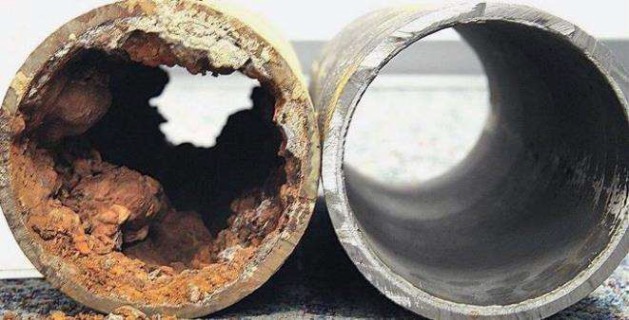Situation
 Every day our 27,000km of water pipes deliver
circa 600 mega litres of clean, wholesome water to
our customers: the equivalent of filling around 240
Olympic sized swimming pools.
Every day our 27,000km of water pipes deliver
circa 600 mega litres of clean, wholesome water to
our customers: the equivalent of filling around 240
Olympic sized swimming pools.
As can be seen in the adjacent picture, deposits naturally build up in our large network of pipes (which is laid out end-to-end would go almost three quarters of the way around the earth). Although harmless, they still require regular cleansing if we are to avoid issues with colour and taste. Traditional methods of cleansing can be disruptive to customers and in themselves may cause water quality issues. Replacement of structurally sound pipe before its end of life due to water quality issues does not represent value for money.
Action
Within the Ballygomartin area of West Belfast, our Water Mains Rehabilitation team have piloted several innovative techniques.
A unidirectional flushing (UDF) technique moves water from a clean source through a “dirty” pipe and out, working in one direction and one segment at a time, maintaining customer supplies whilst at the same time generating the requisite velocity of water in the mains to provide cleaning. The techniques provides a 65% saving over conventional flushing technique. The mains are cleaned leaving only clean water behind the flush and significant improvements in water quality are obtained.
This process of Air Vortex mains cleaning uses water droplets injected into an air vortex, blown by a compressor through the main to clean remove manganese, biofilms and other soft deposits. The process removes sediment and soft deposits from the water mains.
Mains Conditioning is a non-invasive technique that uses managed flow increases above peak daily demand to increase shear stress and remove deposited material from the pipe wall. It is applied to trunk mains that have been identified as posing a high risk to discolouration so that unplanned hydraulic disturbances do not result in significant deposit release. Repeating the process regularly, produces a conditioned network with lower risk of material being dislodged by pipe bursts or water abstraction for fire-fighting that result in discolouration related issues for customers.
Results
There has been less disruption to customer, an improvement in water quality and reduced cost. The key learnings of this study have resulted in a task team being established to develop the concept further and to provide evidence to the Utility Regulator and DfI . This is a ‘do the right thing’ project task team as we strive to avoid replacing watermains that are not at their end of life where there is a low impact, low cost, low carbon solution available.